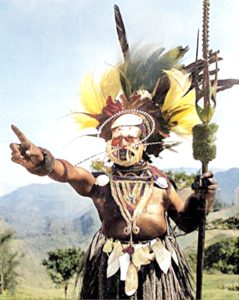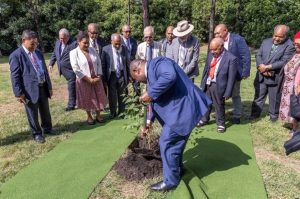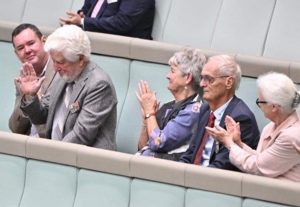The Kiap Memorial:or How We Got Promised One A PERSONAL PERSPECTIVE
Bill Sanders
Between 1878 and 1977, 85 kiaps died in Papua, New Guinea, and the Territory of Papua New Guinea (TPNG). Variously, hostile inhabitants, disease, executions by the Japanese, volcanic eruptions, vehicle accidents, drowning, air crashes, and for some, the overwhelming nature of the job, took their toll. Statistically, PNG was four times more dangerous than the Vietnam War. The Kiap Memorial is for them. Any errors, historical or of fact, are mine and will be willingly corrected. My experience as a kiap was mostly in Simbu, with brief stints on the Sepik, then Madang, and Namatanai. Each of my colleagues and those who had served over many years had a unique experience that set their view about PNG.
KIAPS: Since 1878, field officers had the titles of Patrol Officer, Assistant Resident Magistrate and Resident Magistrate, and provided law and order in British New Guinea or Papua.
Not until 1914, when Australia captured Rabaul, the word went out for patrol officers to replace the German administrators in German New Guinea (GNG), and the term kiap came into use. The locals of GNG knew what it meant, so the Australian administration used it.
World War I, the time between the two wars, and then during WWII especially, tested the kiaps in the field. So many got hurt, ill, taken as POWs, or were executed.
In 1948, Papua and New Guinea started the return to civilian administration. On the first day, the first intake of cadets at the Australian School of Pacific Administration (ASOPA), were told by the Administrator of the Australian territories of PNG, Colonel JK Murray: ‘Time is moving faster in New Guinea than the Europeans. Our aim and obligation in native administration are to work ourselves out of a job.’ (ASOPA Archives, Keith Jackson, PNG Attitude).
Thirty kiaps who trained at ASOPA did not come home. Several of us are having a conversation with Harbour Trust about placing a memorial there, to remind visitors of those who went to PNG from that site, on our country’s behalf.
Colonialism: Was Papua New Guinea a colony? ‘Yes and no’. British New Guinea—the Territory of Papua—was eventually annexed by Britain under protest in 1888, and formally handed over to Australia in 1906. A colony.
German New Guinea was a colony until it fell under Australian military control on 11 September 1914, and remained so until 9 May 1921. The League of Nations gave Australia the Territory of New Guinea (TNG) as a mandate in April 1921, to administer and determine what could or could not be done.
In the 1960s, during the United Nations’ decolonisation period, TPNG came to notice, and pressure was applied on Australia to get moving on self-government. Sir Hugh Foot was a regular visitor over many years and commented adversely on, for example, the provision of education in 1962.
I mention all this as kiaps were seen to be the face of Australia in TPNG and part of Australia’s ‘colonialism’. I believe though that kiaps usually had the best interests of Papua New Guineans at heart. I think of my personal experience in the Highlands, but I am very mindful of Bill Brown’s involvement with the takeover of land for CRA on Bougainville. His account, A Kiap’s Chronicle, is available on the PNGAA and PNG Attitude websites and provides grounds for criticism of the TPNG Administration and the Australian Government. Bill did his best to help the people who were about to lose their land at the mine site.
As a result of kiaps being part of the ‘system’ in Papua, New Guinea and TPNG, I am of the firm belief that some Australian politicians, bureaucrats, and some academics were not enthusiasts of kiap administration. Therefore, there was going to be no formal recognition, vote of thanks, or memorials, in the 1980s or 1990s.
Around 2000, an online conversation started, about remembering those kiaps who died on the job. The consensus amongst the kiap ‘community’ was that: ‘yes,’ there should be a memorial of modest dimensions (totally, totally, unlike the Strzelecki Monument at Jindabyne—five metres in height, with a three metre, 3-tonne, bronze statue pointing at the mountains, donated by Poland. It cost them $1.5 million!).
In 2009, Chris Viner-Smith OAM lobbied the Federal Government for official recognition which resulted in the award of the Police Overseas Service Medal. The words said at the time were very positive and recognised the nature of kiaps’ work in the bush. But not all kiaps lived in the bush or had police duties, so, a number of kiaps did not accept the medal. Quite a few were just not interested.
Moving on, in 2016, a group of kiaps started to consider an area in Kings Park in Canberra, and the conversation about a memorial continued on the ex-Kiap website, with ideas being considered. Being unable to fund any memorial we next approached several politicians, and received a positive response from Luke Gosling MP, member for Solomon in Darwin. After several years of work by him, and David Smith MP, the member for Bean in Southern Canberra, the idea was promoted within government—but the outcome of that was unknown to us!
The Honourable James Marape, Prime Minister of PNG, visits Canberra in February 2024
After our Prime Minister addressed the PNG House of Assembly in 2023, at the subsequent press conference, the PNG PM made an aside to our PM. Roughly it went something like this:
I want to appreciate the help of Australia and acknowledge the missionaries, and the kiaps. We remember the soldiers, but I want to remember the kiaps, those very young men who walked the hinterland of this country and helped develop our Nation.
A return invitation was issued to Mr Marape to address our Parliament, and the PNG PM arrived on 7 February 2024. Listen to what he had to say in his address to Parliament; it was historic:
Thank you, Australia, for what you did, have done, and continue to do: we are family and joined at the hip!
The concept of a Kiap Memorial was then picked up by DFAT for the visit. There is little public information available, however, I would say that from the PNG PM’s words, he was the prime mover, with our own MPs in there.
The itinerary for his February visit was:
Day 1: Welcome to Country, Visit the National Archives, Plant a tree, Parliamentary Dinner.
Day 2: Address to Parliament.
We had no idea about what was coming!
I thought that the invitation was pretty open. So, I said: ‘no’ to the Welcome to Country, and was going to say ‘no’ to the tree planting. DFAT asked me to say a few words at The National Archives, and I was standing there trying to be inconspicuous when the PNG PM sidled up and said: ‘Aah, wantok.’ ‘Yes,’ I said. The Director of National Archives spoke, then me for two to three minutes:
Welcome ol leader man. These archives hold the story of PNG and Australia’s part in it. In 100 years’ time, when people want to learn about the PNG-Australia relationship, they will come here to read the original letters and documents.
I note that the PNG PM used that last bit in his address to Parliament. Then we looked at letters and files …
Off to the tree planting; originally I’d said: ‘Nah, not really.’ The message came back: ‘You’ve got to be there, this tree is for you kiaps’. ‘Oh, sh*t! OK, I’ll be there.’
The drive to Commonwealth Park was surreal, with police stopping traffic at the lights, down Kings Avenue onto Parkes Way, then Commonwealth Avenue. This was all about 4.30 pm when traffic was building! Never been in a motorcade before!
Through all the locked gates in Commonwealth Park down to the foreshore next to Regatta Point. Walked over to where the tree is waiting … speech … a bit more of what had already been said. Mr Marape mentioned that Grand Chief Sir Michael Somare had planted trees in PNG for the shelter of future generations; and that he was now doing the same in Australia.
The tree kept falling over in the wind, so Mrs Marape pushed the stake through into the ground to hold it while the talking was going on!
It’s a Brittle Gum by the way. And I look forward to a plaque there, irrespective of where the National Memorial goes. Mr Marape indicated he expected the memorial to be nearby.
That evening was the Parliamentary Dinner—upstairs in one of the smaller dining rooms—120 people—a who’s who of those with a connection with PNG. I shared a lift with Mal Meninga, and sat at a table with another kiap, Graham Watts, David Smith MP, a banker, and a PhD student from Manus at ANU. Spotted in the distance, were Penny Wong, Julie Bishop, the US Ambassador, Pat Conroy, the Chief Justice, and more!
Then our PM spoke, the Opposition Leader spoke, and then Mr Marape spoke. It was a scaled-down version of what he said the next day in Parliament; thanking Australia. But, at the end, he asked Graham Watts, John Hocknull OAM, ML and me, to stand. ‘Thank you for your contribution to PNG.’ Applause! Sat down, completely nonplussed. The food was fabulous and the wines—to die for. Then suddenly, it was all over. We were the last to leave!
The next day, Thursday, 8 February 2024, was the address to our Parliament. Sitting waiting from 9.15 am, it was ‘spot the politician’: Bob Katter, senators, our PM, lots of familiar faces. Mr Morrison made it by the skin of his teeth, as the Clerk of the House announced Mr Marape. The seniors in his delegation were already seated—left rear, along the wall.
Our PM welcomed Mr Marape. The Opposition leader welcomed him. Then the PNG PM was invited to speak. He spoke of the last PNG leader to address Australia’s parliamentarians, Kondom Agaundo, from Simbu, many years ago. That Kondom Agaundo was laughed at, and he responded by saying: ‘One day my sons will come here and address you in your language.’

Leader and politician Kondom Agaundo MLC, Simbu, early 1960s (Photo copied from Facebook per the 1966 book by American explorer and writer, Lewis Cotlow, titled ‘In Search of the Primitive’)
Mr Marape said: ‘That day has come, and I address you in the language you have taught me.’ He thanked Australia for all that it had done, that we are neighbours, family, and asked that Australia not give up on PNG. He then thanked missionaries and kiaps for what they had done. In the next breath, he named John, Graham and me.
Being in Parliament was special, but to be named and have senators and MPs look up at you, applauding! That was another surreal moment. We should have known it was coming, we should have stood. I was really quite stunned. It was a very emotional moment and it has had an impact on me.
The acclamation from the leaders of our nation was, for me, accepted on behalf of all those kiaps who did the hard yards over many years; who broke bush, patrolling in atrocious conditions, going to places where people just don’t go—those who came home ill, those who to this day bear scars from being on the receiving end in tribal fights; but especially for those who didn’t come home, and for those for whom it all became too much.
For those people I knew, and who I look up to with respect: Laurie Doolan, John Frew, Noel Walters, Morrie Brown, Jack Karukuru, Sir Jerry Nalau, Bernie Maume, Laurie Bragge, Wilhelm Speldewinde, Lee Clayton, Garth Donovan, Alan McLay, Dave Bawden, Peter Salmon, Steve Daniels, Edward Konu, but my memory grows dim … they all had an impact on my life.
After the Parliamentary Address was delivered, the assembled senators and parliamentarians spoke to Mr Marape. John Hocknull and I were interviewed by the ABC Tok Pisin Service. Then we went and had coffee. ‘Thank you Luke Gosling, MP.’ We just looked at each other: ‘What just happened?’ Off to lunch and to show our respective families the Kiap Tree. And finally, home, feet up.
It’s 8 pm that night— the phone rings. A PNG number: ‘Hello, this is Grace. Sorry about the late notice, but the PM would like you to come to dinner.’ ‘Of course! love to.’
I was seated with the PM and Mrs Marape; they asked me about my life in Simbu. I spoke at length to Sir Nambuka Mara, the first Premier for the Western Highlands, and who knew Noel Walters well.
At one stage I’m listening to the Governor of Western Highlands speaking to the PM about the day:
‘… you were the first PM who could do that address today. Your predecessors couldn’t have.’
Then young Marape Junior drops by to say hello to Mum and Dad. And again, suddenly it was done. The PM stood up, a signal that the gathering was over.
In the joint statement made by the two Prime Ministers is an undertaking to have a memorial, with ground turning to occur in 2025.
To end: It took a Papua New Guinean Prime Minister to get Australia to acknowledge the work of kiaps in PNG and to get us the memorial. To this day, the goodwill in PNG towards Australia and us kiaps is enormous. I find the acclamation from young Papua New Guineans who I come across sometimes, a tad embarrassing. They say things like ‘My dad, my bubu, granddad, told me stories about what you kiaps did for us and how you brought us to independence. Thank you.’ My response is: ‘Well, it was a team effort, but your thanks are accepted on behalf of all those who were there …’





